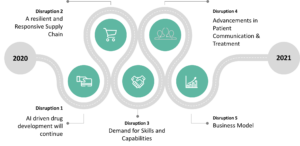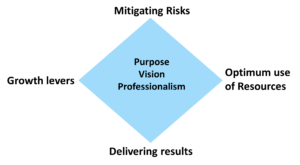Overtime pharma industry is realising that duly deserved place of preventive medicines need to be focused on specifically in this disruptive climatic, social, economic and political situation. Recent pandemic accelerated this thought in such a way that it is not only the prevention but also the concomitant use of pharma products along with nutritional products.
The pandemic has proven that Indian healthcare industry is one of the most responsive industries for supplying key medicines across globe; managing workforce safety and preparing vaccines and therapeutics with evolving government restrictions.
With these achievements, industry has started taking stock of what lies ahead. This will likely to bring fundamental disruptions in industry operations. Even the ‘Healthcare Focused Budget’ would like to experience reforms in terms of increased spending on public health, fund allocations for tele-medicine to connect villages for healthcare reach, introduction of Phase II Production Linked Incentive (‘PLI’) Scheme to manufacture APIs and reduce dependency on China for APIs, etc.
It has been very evident that, in future Indian Healthcare industry needs to have a resilient infrastructure as well as supply chain to absorb new shocks. The lessons of 2020 can be building blocks to prepare ourselves and consider new business model.
- Advantages of Technological Applications:
Industry is expecting to see growing traction of “nichebusters” rather than the old-fashioned blockbuster model. The industry is looking at unmet needs and developing drugs to address that need. This “nichebusters” concept is growing towards development of precision medicines to ensure “the right patient or patient population for targeted therapy with precise molecule”.
Also, pandemic has proven that industry needs to optimize the clinical trial process. Invention of “Fast-track” COVID-19 vaccine has really been a boon to entire human race. Several strategies have been used to optimize clinical trials and reduce the vaccine generation time. This will be taken as a priority in next year for the development of other drugs as well.
Radiomics is the emerging technology which enables drug developers to gain deeper insights from medical images. This will accelerate therapy development and will also help discovery of new biomarkers that will enhance clinical decision-making and treatment.
In terms of supply chain, industry has already started gaining full transparency and visibility across the value chain with the growing adoption of industry 4.0. With this pandemic, industry has started re-evaluating their strategies, risk tolerance, and overall network footprint to address issues in supply chain. This may increase dependency in local supply chain than global one. Also, the increased adoption of digital tools, telehealth, and app-based ecosystems make patient-level data more available and hence, this data should be considered to serve the demand through patient-centric supply chains.

Source: Interlink Knowledge Cell
Img. 1.1 Disruptions Industry Likely to Experience in FY 2021-22
- Challenges faced by evolved Working patterns:
Post-COVID-19 industry is likely to adopt more efficient ways of working. Out of necessity, organizations have shifted towards lean organisational structure to be more efficient and productive.
The working model will be Hybrid as organisations need manage working in field as well from home as well. Accordingly, systems, processes and norms are need to be consolidate for smooth operations.
Also, in a quick response to the pandemic, industry started looking for effective collaboration for solving business problems and challenges. So, the new term emerged as “cross-functional work culture”. The thought behind this was the cross-functional work strategies will play an essential part in brainstorming, idea generation and presenting innovative business solutions. And this trend will continue to grow next year as well. New capabilities will also be needed in coming years as the workforce shifts from manual skills to more technical skills.
- Awareness of Patients and thereby Communication:
Digital transformation in the pharmaceutical industry was already there even before COVID-19, but in the pandemic time this shook the Healthcare world to its foundations. And patient communication is no longer an exception!
Digital leaders such as Amazon and Google started seizing opportunities to develop virtual platforms for personalised patient communications.
Healthcare practitioners stared valuing and depending on digital tools as well as tele-medicine. This technology has overcome physical barriers to interaction (especially under COVID-19), broadened the healthcare conversation, facilitated information flow with patients, encouraged treatment adherence and percolated self-management of chronic diseases in patients. One of the best examples of this is AI-driven pathological testing. This emerging technology is assisting to analyse thousands of pathology images of various cancers to provide highly accurate diagnoses and predict the right anti-cancer drug combinations. The other example is Chatbots. This is a virtual health assistant that can fill a multitude of roles from customer service representatives to diagnostic tools and even therapists.
Even, healthcare consumerism has gained the momentum in 2020. The way patients used to receive information is changed now. Now, patients are likely to expect knowing costs of medications, procedures, etc. Patient consumerism has brought transparency via drug discount cards and other online services. Also, telemedicine as well as e-health gadgets experienced a widespread adoption during the pandemic and are likely to be continued in near future.
When COVID-19 vaccination campaigns have already, there will be an impetus for patient information sharing. The entire campaign needs to manage with systems and get data on how Covid-19 vaccines are distributed, sharing data with pharmacists, doctors as well as state and federal government entities. And, blockchain can be used to be an effective tool in improving the accuracy of medical records and cutting cost.
- Challenges to Build New Business Model:
Traditional ways of working are quickly getting displaced with new ways. Now companies need to focus on multiple short term goals to achieve a long term vision. Sustainability and stability have become important factors for every organisation to grow post-COVID-19. Organisations need to be strengthened internally with vision and mission and this can be supported with work culture.

Img. 1.2 Disruptions Industry Likely to Experience in FY 2021-22
And this can be achieved only after leveraging on growth levers, mitigating risks, optimum use of resources and focusing on delivering results. With these four drivers industry can still achieve a strong level of continuity and grow in post-COVID era.
This article has been written by Dr. Smarta- CMD (Interlink) and published by e-version of Business World.
